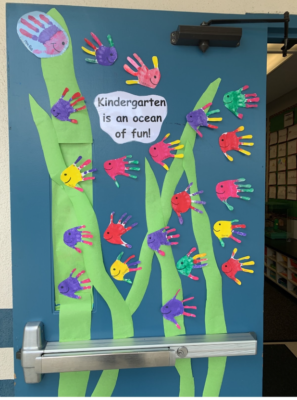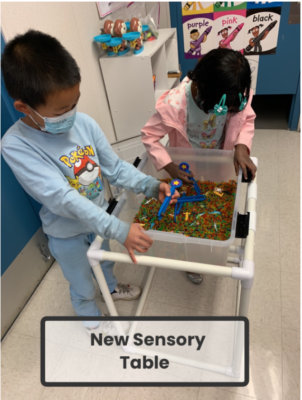
Using imagination to inspire the learning process, kindergarteners pretended to be sea animals. Throughout this process, they learned important scientific and social skills. Kindergartners taught families and community members about various sea creatures, highlighting how we can protect them and our environment. They even designed their own costumes!
The Launch

Finding Dory was a great movie to ignite a passion for sea animals. Not only did they learn the names and traits of various sea animals, they also learned about aquariums, pollution, and environmental protection. This was the perfect launch for our Project-Based Learning Unit on Sea Animals.
Kindergartners were challenged to answer the following question:
How can we, as sea animals, survive in the ocean and teach others about our needs?
The Project

After learning a bit about various sea animals, the kindergartners chose which sea animal they wanted to study. In collaborative groups, they began to research and become experts on their chosen sea animal. Through books and videos, they research six core categories:
-
-
-
-
-
-
-
-
- physical characteristics
- diet
- movement
- self-protection
- fun facts, and
- how people can help protect sea animals.
-
-
-
-
-
-
-
Each kindergartner completed a written research report containing all these topics.
Collaborative Groups to Research Chosen Sea Animal
Student Reading her Sharks Research Report
Once they were experts on their sea animal, each group designed a costume that contained the important physical characteristics of their animal. The classroom was transformed into an ocean of sea life. Dressed in costumes, they behaved like their sea animal. Sea turtles pursued crabs, who defended themselves with their pincers. Seahorses blended into their surroundings, changing color as needed. Watch out for jellyfish — they stink!

The students made handprint fish that keep our door in theme with the PBL.

Our turtles handmade custom shells to display all the detail that goes into a turtle’s “home.”

Students practice fine motor skills while using tweezers to find hidden sea animals.
Making it Public
The kindergartners completed their project by performing for families and community members. Dressed as their chosen sea animals, they taught others important facts about themselves. They even gave ideas about what people can do to better protect these creatures.
Sea Animal Performance – Dress Rehearsal
Conclusion
The families were so excited to see their children perform. Many recorded the event to capture the beautiful costumes and hold on to this special memory. Kindergartners were exclaiming they were going to be a sea animal for the next Halloween and wear their costume. They clutched their sea animal book with proud little hands, showing it to everyone who walked by. Kindergartners became experts on their chosen sea animals, and quite knowledgeable about many others. More importantly, they gained the knowledge and tools to become good stewards of the ocean environment. I hope they continue to spread their knowledge and conservation efforts for years to come.
*****
 Paula Ford graduated from the University of California at Davis with a Bilingual Cross-Cultural Language and Academic (BCLAD) multiple subject teaching credential. She also has a master’s degree in Curriculum and Instruction and Early Childhood Education. She has been teaching for over twenty years. She began her career in bilingual education and then moved to teach second language learners.
Paula Ford graduated from the University of California at Davis with a Bilingual Cross-Cultural Language and Academic (BCLAD) multiple subject teaching credential. She also has a master’s degree in Curriculum and Instruction and Early Childhood Education. She has been teaching for over twenty years. She began her career in bilingual education and then moved to teach second language learners.
Paula taught kindergarten, first grade, and third grade, and has been a resource teacher for grades transitional kindergarten through fifth grade. The majority of her career has been teaching low-socioeconomic English language learners. Currently, Paula is teaching kindergarten at Manuel De Vargas Elementary School, and she absolutely loves it.
Make sure you follow Paula on Twitter at @prford5
Rethinking Learning Podcast with Paula:
Episode #4: Conversations about PBL
More posts on Rethinking Learning from Paula:
World Changers PBL by Paula Ford
****
Make sure you check out more of the Rethinking Learning podcasts and each post that the guests created. Click on this link or the logo below to list by episode, alphabetical, or reflections. |
I am also the co-host of the “Real Talk” podcast with Nicole Biscotti. We delve deep into the topic “Authenticity in a Polarized Society.” Click on RealTalkBN or the logo below. |
I’m getting wonderful feedback on how much the information and stories in “Define Your Why” has helped them. For more information about this book, go to this page or click on the book for resources, questions, and links. |
My latest book, “Grow Your Why…One Story at a Time,” includes 23 stories from inspirational educators, innovators, and entrepreneurs. Go to this page or click on the book to go to Why Press Publishing for launching, details, and resources. |


